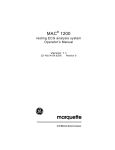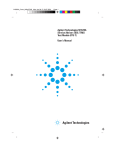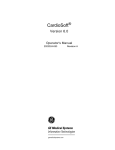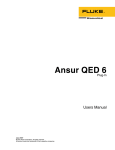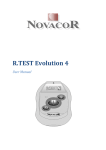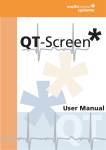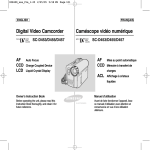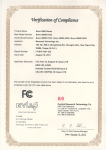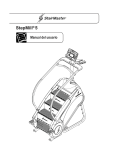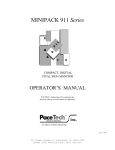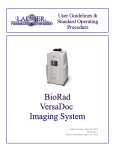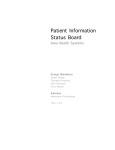Download EKG Graph Paper
Transcript
Banner Staff Service ECG Study Guide Edited by Larry H. Lybbert, MS, RN Table of Contents ECG STUDY GUIDE ................................................................................................................................................... 3 ECG INTERPRETATION BASICS........................................................................................................................... 4 EKG GRAPH PAPER ..................................................................................................................................................4 RATE MEASUREMENT ...............................................................................................................................................9 The Six Second Method ........................................................................................................................................9 Large Box Method................................................................................................................................................9 Small Box Method ................................................................................................................................................9 BASIC EKG RHYTHM ANALYSIS GUIDE ................................................................................................................11 Rhythm Interpretation ........................................................................................................................................13 Six Basic Steps for Rhythm Interpretation Summary .........................................................................................13 NURSING PRIORITIES AND POTENTIAL TREATMENTS ............................................................................................14 Bradycardia .......................................................................................................................................................14 Tachycardia .......................................................................................................................................................15 Cardiac Arrest....................................................................................................................................................16 BASIC CHARACTERISTICS OF CARDIAC RHYTHMS .................................................................................................17 TYPES OF RHYTHM................................................................................................................................................ 19 NORMAL SINUS RHYTHM .......................................................................................................................................19 SINUS BRADYCARDIA .............................................................................................................................................20 SINUS TACHYCARDIA .............................................................................................................................................21 PREMATURE ATRIAL CONTRACTIONS (PACS) .......................................................................................................23 ATRIAL FIBRILLATION ............................................................................................................................................24 ATRIAL FLUTTER ....................................................................................................................................................25 JUNCTIONAL RHYTHM ............................................................................................................................................26 ACCELERATED JUNCTIONAL RHYTHM/JUNCTIONAL TACHYCARDIA ....................................................................27 ATRIOVENTRICULAR BLOCKS ................................................................................................................................28 1ST DEGREE AV BLOCK .........................................................................................................................................29 2ND DEGREE AV BLOCK (MOBITZ TYPE I, WENCKEBACH) ..................................................................................29 2ND DEGREE AV BLOCK (MOBITZ TYPE II)...........................................................................................................31 3RD DEGREE AB BLOCK / COMPLETE HEART BLOCK ...........................................................................................32 VENTRICULAR RHYTHMS .......................................................................................................................................34 PREMATURE VENTRICULAR CONTRACTION (PVCS)..............................................................................................35 VENTRICULAR TACHYCARDIA ...............................................................................................................................37 VENTRICULAR FIBRILLATION .................................................................................................................................38 ASYSTOLE ...............................................................................................................................................................39 POLYMORPHIC VENTRICULAR TACHYCARDIA (TORSADE DE POINTES) ................................................................40 IDIOVENTRICULAR (IVR) .......................................................................................................................................41 ACCELERATED IDIOVENTRICULAR (AIVR)............................................................................................................42 PACED RHYTHMS....................................................................................................................................................43 Pacemaker Summary..........................................................................................................................................46 CONCLUSION ........................................................................................................................................................... 47 2 ECG Study Guide ECG Assessment Testing is an assessment of your basic knowledge and should be completed as part of your new hire process. Although we are sure that you know the information, you need to study this information to be prepared to pass the test. Please remember the following guidelines: The study guide is a good overall review of the components of the ECG waveform and more common dysrhythsmia. You will need to be able to recognize the four lethal rhythms. Asystole, Ventricle Tachycardia (VT), Ventricle Fibrillation (VF), and Polymorphic Ventricle Tachycardia (Torsade de pointes). Use this study guide and other resource books to review ECG interpretation. You will be expected to calculate rates properly interpret each strip. Practice measuring your strips in the study guide. The rhythm strips on the exam are NOT 6 second strips. Use calipers or the attached handout to determine rates. Memorize your blocks…there are several rhythm strips on blocks. Rules for passing the exam Minimal passing score = 85% If you do not correctly identify any of the following rhythms, you will be required to retake the exam, even if your test score is above the passing score. o Ventricular tachycardia o Ventricular fibrillation o Asystole o Torsade de pointes If you correctly identify the four lethal rhythms and achieve an overall score of at least 85%, you have passed the exam. For Information Purpose Only The 2010 ECC Adult algorithms for cardiac arrest, bradycardia with a pulse, and tachycardia with a pulse are included in this study guide. Changes have occurred with the 2010 guidelines, so please take time to review the following link: http://guidelines.ecc.org/pdf/90-1043_ECC_2010_Guidelines_Highlights_noRecycle.pdf Questions, Give us a call. Larry Lybbert, RN, BSN, MS Banner Staffing Services 480-684-6428 [email protected] Angela Stone Banner Staffing Services 480-684-6427 [email protected] 3 ECG Interpretation Basics EKG Graph Paper The paper used to record EKG tracings is grid like in nature and has specific markings utilized to mark length in seconds. The paper is divided into large and small boxes. Thicker darker lines separate large boxes; thinner lighter lines separate small boxes. x The dark vertical lines are 0.20 seconds apart. x The lighter vertical lines are 0.04 seconds apart x Each small box is 1mm in size x Each small box represents an electrical current that is equal to 0.1 (millivolt) mV x One mV is equal to two large boxes 4 Normally EKG graph paper has thick dark lines at the top or bottom of the paper. In the strip presented here, the lines are at the bottom of the paper. The space between the lines is equal to 3 seconds. A standard EKG strip is run over 6 seconds. When printing an EKG rhythm strip the paper prints at a standard speed of 25 mm per second. 5 omponents of the Normal EKG Waveform The EKG is a real-time recording of the hearts electrical activity, produced by depolarization and repolarization of the hearts cells. The EKG waveform consists of : x P Wave: Represents atrial depolarization x QRS: Represents ventricular depolarization x T Wave: Represents ventricular repolarization Intervals are described as the length of time between one waveform and the next. Isoelectric Line: Flat line of the EKG tracing represents no electrical activity, and is referred to as the baseline. Deflections above the isoelectic line are positive, and deflections below the isoelectric line are negative. P-Wave: The SA node produces an electrical stimulus the P wave, normally upright, usually no more than 3mm in height. PRI (PR Interval): Is representative of the spread of the atrial depolarization wave, and the time it takes for the impulse to conduct through the AV node and to the ventricles. The PRI is marked from the start of the P-Wave to the beginning of the QRS. The PRI is normally no more than 0.20 seconds in length. QRS Complex: The QRS represents depolarization of the ventricles and ventricular conduction time of the electrical impulse. Typically the QRS is narrow with a conduction time of no more than 0.12 seconds. The QRS is measured from the beginning of the first waveform to the point at which the waveform returns to the isolectric line. The QRS is made up of: x Q-Wave: First negative deflection from baseline (below the isoelectric line), x R-Wave: Positive deflection from the baseline (above the isoelectric line). x S-Wave: Negative deflection following the R-Wave (below the isoelectric line) x R’ (Prime) is a secondary positive wave that may represent abnormal ventricular conduction. 6 Below are examples of the shapes that the QRS complex may take: ST-Segment: Represents early ventricular repolarization, and extends from the end of the QRS to the beginning of the T-Wave, it is normally even with the isoelectric line. A deviation either above or below the isoelectric line represents myocardial injury or ischemia. Basic facts of the ST segment. The ST segment starts at the end of the QRS and ends at the start of the T Wave. The ST segment represents the early beginning of ventricular repolarization. The portion of the EKG tracing where the QRS ends and the ST segment begins is called the J Point. Characteristics: The ST-segment normally remains “Isoelectric” which is the normal baseline of the EKG. Elevation greater than 1mm in two or more reciprocal leads may indicate injury. Depression greater than 1mm in two or more reciprocal leads may indicate myocardial ischemia. T-Wave: Represents ventricular repolarization as the ventricles return to a state of relaxation. The TWave is typically rounded and systematical. The T-Wave is typically upright however, this may vary if myocardial injury or ischemia is present. QT-Interval (QTI): The QTI represents the refractory period of the ventricles (The QT interval represents total ventricular activity), as they depolarize and repolarize. It begins with the first wave in the QRS complex representing ventricular depolarization, and ends when the T Wave returns to baseline at the isoelectric line, representing ventricular repolarization. As rule of thumb, a normal QTI is less than 0.40 seconds. The QTI is directly related to the heart rate. 7 Normal Measurements of the QTI: 0.36-0.40 It is best to measure the QTI in a lead in which the T wave is most pronounced. The normal overall length of the QTI should be equal to or less than ½ of the R-R interval. Summary of Heart Measurements: x P-Wave: Upright in lead II x PRI: < 0.20 Sec x QRS: < 0.12 Sec x ST-Segment: Even with isoelectric line x T-Wave: Upright in lead II x QTI: < 0.40 Sec 8 Rate Measurement The patient’s heart rate reveals a great deal of information. If the rate is slow (under 60 beats per minute), we call it bradycardia. If the heart rate is fast (over 100 beats per minute), then it is called tachycardia. ECG monitors display the heart rate. When an ECG strip is printed, most printers provide heart rate information at the top of the strip. Never the less, you might be in a situation where you must calculate the heart rate from the ECG recording. There are numerous methods and formulas, which can be used to calculate a heart rate from the ECG. Three methods for heart rate calculation are presented below. The Six Second Method This method can be used with either regular or irregular rhythms and provides a rough estimate (but not precise) of heart rate. Print a 6 second strip (see text box if you are not sure how to do this). Count the number of R waves in a 6 second strip and multiply by 10. For example, if there are seven (7) R waves in a 6 second strip, the heart rate is approximately 70 or (7x10=70). Let’s give it a try. Look at the rhythm below and count all the R waves. Large Box Method Count the number of large squares between two consecutive R waves. Divide this number into 300 for a ventricular rate. For example, if there are four large squares between regular QRS complexes, the heart rate is 75 (300/4=75). For an atrial rate, count the number of large boxes between two consecutive P waves and also divide into 300. Small Box Method This method also uses an “R to R” or “P to P” measurement, but is more precise because we use the smaller ECG boxes to help us calculate the heart rate. To calculate the ventricular rate, count the number of small boxes between two consecutive R waves and divide by 1500. To calculate the atrial rate, count the number of large boxes between two consecutive P waves and divide by 1500. For example, if there are two small squares between regular QRS complexes, the heart rate is 75 (1500/20 = 75). 9 Quick Method (used when rhythm is regular) Find an R wave that falls on a thick vertical line and count the number of boxes until the next Rwave. The duration between two consecutive R-waves is referred to as the RR interval. Then use the number range above, counting down for each large box. o 1 Box = 300 beats per minute (bpm) o 2 Boxes = 150 beats per minute (bpm) o 3 Boxes = 100 beats per minute (bpm) o 4 Boxes = 75 beats per minute (bpm) o 5 Boxes = 60 beats per minute (bpm) o 6 Boxes = 50 beats per minute (bpm) 10 Basic EKG Rhythm Analysis Guide The ECG tracing provides a variety of clues as to what is happening within the heart. These clues include heart rate, regularity or irregularity of the rhythm, interval measurements and characteristics of each individual waveform. Think of the ECG strip as a unique fingerprint in which you are the detective conducting the investigation. Like a detective, you will need to pay attention to details. In addition to a detailed analysis, you will also need a “recipe” for ECG interpretation, just like a cook needs a recipe for a complex dessert. If you follow the interpretation “recipe” each time you analyze a strip, your skills will grow and your interpretations will be consistently accurate. Remember to print a 6 second strip (or longer) each and every time you begin an interpretation. Follow the six basic steps (your recipe) for rhythm interpretation. When looking at a cardiac rhythm ask yourself the following questions. 1. Calculate heart rate Calculate both the atrial and ventricular rates. Normally the atrial rate is the same as the ventricular rate. Is this true in the ECG strip you are analyzing? Remember the normal heart rate for most individuals falls between the range of 60-80 beats/minute. Normal Findings: Ƈ7KH+5VKRXOGEHEHWZHHQ-80 beats/minute. Abnormal Findings: Ƈ+HDUWUDWHVOHVVWKDQEHDWVPLQXWHDUH typically labeled as slow or bradycardic. Ƈ7KHDWULDOUDWHVKRXOGEHWKHVDPHDVWKH ventricular rate. Ƈ+HDUWUDWHVJUHDWHUWKDQEHDWVPLQXWHDUH typically labeled fast or tachycardic. 2. Regularity of the rhythm The assessment of the regularity of the rhythm - Is the rhythm regular or is it irregular? To assess the regularity, you will need to place the legs of your calipers on two consecutive R waves. This is your “R to R” or “R-R” interval. Without moving the width of the calipers, march through the rhythm as you travel from R wave to R wave. If you do not have calipers, another method to determine regularity is to make a small mark on a piece of paper over two consecutive R waves, then move the paper to the next R wave and see if the dots line up/march out. Do the R waves follow a regular pattern? If so, the ventricular rhythm is called regular rhythm. Normal ECG rhythms are regular in their pattern. If the R-R interval varies in the number of ECG small boxes between them, you are dealing with an irregular rhythm. Do the same type of assessment with the atrial rhythm. Put your calipers at the beginning (or upslope) of a P wave. Put the other end of your caliper at the beginning of the next P wave or make a small mark on a piece of paper over two consecutive P waves. This is the P-P interval. Lift your calipers and begin marching through the strip looking for the pattern of regularity of the P waves. If the SA node is firing at a constant beat, the P-P interval will be regular. Do not estimate. Use an EKG caliber or paper. 11 Normal Findings: The R-R intervals are regular. The P-P intervals are regular. There is one P for every QRS. Regular rhythm Abnormal Findings: The R-R intervals are irregular The P-P intervals are irregular. There is more than one P for each QRS. Irregular Rhythm Very few rhythms are irregular. For example, atrial fibrillation is always irregular (more on this rhythm later). Therefore, if your rhythm is regular it cannot be atrial fibrillation. 3. Examine P wave First, you must go on a “P hunt” and find the P waves. Once you have identified them, assess their characteristics. Normal Findings: P waves should be regular (march out the P-P intervals with your calipers). P waves have a symmetrical shape, usually upright and rounded P waves should all look alike (uniform) and should point in the same direction There should be one P for every QRS (or a 1:1 relationship). The QRS associated with P-waves Abnormal Findings: A P wave is not followed by a QRS complex. There are more P waves than QRS complexes. completely dissociated The QRS complexes are completely dissociated from P wave 4. Measure PR interval Remember that the P to R interval represents the time it takes an impulse to travel from the atria through the AV node. The P to R interval is measured from the beginning of the P wave to the beginning of the QRS complex. This is a bit confusing as you might think it is a measurement from the beginning of the P wave to the beginning of the R wave.... but it is actually only measured from the beginning P to the beginning of the Q wave. Think of it as a “P to Q measurement” despite the fact that it is called a PR interval. x Normal Findings: The PR interval (or time travel from SA to AV nodes) is between 0.12 to 0.20 seconds. The PR intervals are constant throughout the rhythm. 12 Abnormal Findings: The PR interval is > .20 seconds (this might indicate delayed travel time from SA to AV node). The PR interval is irregular in measurement (irregular or varying PR intervals may indicate some type of SA-AV conduction problem and possible conduction heart block). 5. Measure QRS Complex The QRS complex represents ventricular depolarization. The QRS complex consists of three waves: the Q wave, the R wave, and the S wave. It is measured from the beginning of the Q wave to the end of S wave. Normal ventricular conduction and depolarization takes no more than .12 seconds. Normal Findings: All the QRS complexes have uniformity throughout (the same size, shape and direction). All QRS complexes are of equal duration or width. The R to R interval between each QRS is regular. Abnormal Findings: The QRS complexes vary in shape, width and direction. The QRS complex is >.12 seconds wide. The R to R interval between each QRS is irregular. 6. Examine ST segment (should be isoelectric) & Examine T wave (upright, flat, inverted, spiked) Normal Findings: The ST segment should be electrically neutral (or near neutral) and should be sitting on the isoelectric baseline (no greater than 1 mm above or below the isoelectric line is normal). The T wave is upright whenever the R wave is upright. The T wave deflects downward when the R wave is downward. Abnormal Findings: There is > 1mm ST segment elevation or depression from the isoelectric line. The T wave is in the opposite direction than the R wave. Rhythm Interpretation Believe it or not, after completing Step 6, you are ready to make an educated decision on naming the correct rhythm. Remember to correlate information obtained in Steps 1-6 along with your understanding of the heart’s electrophysiology. Rather than pure memorization, if you can integrate the electrophysiology with the rhythm interpretation your patient care priorities and potential treatments will make a lot more sense. Six Basic Steps for Rhythm Interpretation Summary 1. Rate (Calculate the heart rate (HR) or note the HR from the 2. Regularity (Measure the regularity or rhythm of the R waves) 3. P-wave Examination. Is there one P wave before each QRS? (there should be) 4. P to R interval (Measure the P to R interval - Is it within normal limits? It is consistent?) 5. QRS width (Measure the duration of the QRS complex) 6. Rhythm interpretation 13 Nursing Priorities and Potential Treatments (Pediatrics Nurses Required); All Other RNs Informational Only Interpreting the actual ECG rhythm is only the beginning of the assessment and care for your patient. You cannot be successful in your practice if you only know how to interpret ECG. As healthcare provider, you must be able to respond with appropriate priorities and understand initial treatments. Complete comprehensive treatments for each type of ECG rhythm are beyond the scope of this review guide. Nurses must make decisions about the patient’s treatment based on information obtained from the electrocardiogram reading. They must have the ability to read the data quickly so that they can begin medical interventions. Bradycardia Symptomatic bradycardia: Heart rate slower than normal for age or <60 (normal/age on pg.) with any signs of cardiac compromise: altered LOC, hypotension, respiratory distress or failure, poor cap refill) Types of bradycardia: Sinus bradycardia or AV block Treatment of Bradycardia: CPR for HR <60 Maintain airway - Oxygen EPI 0.1ml/kg IV/IO every 3-5 minutes (first line drug for pediatric bradycardia) Atropine 0.02mg/ml IV/IO (for bradycardia caused by increased vagal tone or AV block) Consider transvenous pacing. 14 Tachycardia Tachycardia: Heart rate faster than is normal for the child’s age. Tachycardia with hemodynamic instability signs are: altered LOC, hypotension, poor cap refill, weak pulses, respiratory failure Sinus tachycardia- fast rate depending on age & varies with activity: HR < 220 infants HR < 180 children Treatment: identify & treat possible causes (hypovolemic, shock, fever, anxiety, toxins) SVT- Does not change with activity. Common symptoms are irritability, rapid respirations, poor feeding, poor cap refill, pallor, hypotension, and diaphoresis. +5LQIDQWV +5FKLOGUHQ Treatment: Determine if child is stable vs. unstable. If stable, attempt vagal maneuver (Ice to face). If unstable do immediate synchronized cardio version. Initial synch dose: 0.5-1 joule/kg, Subsequent synch doses: 2 joules/kg Consult cardiology!! Get a 12 lead EKG but do not delay treatment to obtain EKG For SVT resistant to vagal maneuvers: Adenosine 0.1mg/kg (max 1st dose 6mg) Rapid 2 syringe technique VT with pulses-Wide QRS. Uncommon in children. HR Normal for age to >200. Treat underlying causes: possibly due to hyperkalemia, hypocalcemia, hypomagnesaemia, toxins. Treatment for stable VT w/monomorphic QRS: Adenosine 0.1mg/kg IV/IO 1st dose (6 mg max) Adenosine 0.2mg/kg IV/IO 2nd dose (12mg max) Expert consultation Amiodarone 5mg/kg over 20-60 minutes -ORProcainamide 15mg/kg over 30-60 minutes Unstable VT: Synchronized cardioversion 0.5 to 1 J/kg (may increase to 2j/kg if ineffective) For VT refer to algorithms!!! 15 Cardiac Arrest Shockable rhythm: Pulseless VT or VF Start CPR (at least 100 compressions/min with good chest recoil, change compressors Q2 mins) Assess cardiac rhythm Shock immediately if VT or VF (2 j/kg 1st dose) (4j/kg subsequent doses repeat every 2 minutes) Epi 0.1ml/kg every 3-5 minutes Amiodarone 5mg/kg DEAD: Defib Epi Amiodarone Defib Non-shockable rhythm: Asystole/PEA (NO defib…..NO Amio for Asystole or PEA!!) Start CPR (at least 100 compressions/min with good chest recoil, change compressors Q2 mines) Assess cardiac rhythm Epi 0.1ml every 3-5 minutes Identify & treat reversible causes: H’s Hypovolemia Hypoxia Hydrogen ion (acidosis) Hyper-hypokalemia Hypoglycemia Hypothermia T’s Tension pneumothorax Tamponade Toxins Thrombosis Thrombosis 16 Basic Characteristics of Cardiac Rhythms Dysrhythmia Rate 60-100 Sinus Rhythms Normal Sinus P-R Interval Rhythm QRS Interval Regular 0.12-0.20 sec <0.12 sec Comments Sinus Bradycardia <60 Regular 0.12-0.20 <0.12 sec Sinus Tachycardia 100-160 Regular 0.12-0.20 sec <0.12 sec Sinus Arrhythmia 60-100 Irregular 0.12-0.20 sec <0.12 sec Sinus Pause/Arrest Depends on Usually regular pauses with pauses 0.12-0.20 sec <0.12 sec Atrial Rhythms PAC Depends on Interrupts underlying underlying rhythm rhythm 0.12-0.20 sec <0.12 sec Regularity depends on underlying rhythm and number of PAC’s Atrial Tachycardia SVT 150-250 0.12-0.20 sec <0.12 sec P waves may be hidden in previous T due to rapid rate Variable <0.12 sec “Sawtooth” pattern F waves Regular Atrial Flutter V rate varies Irregular A rate 250350 Rhythm varies with respiration Atrial Fibrillation Controlled >100 AF <100 Uncontrolled AF Irregular Nonmeasureable <0.12 sec Wandering Pacemaker 60-100 Irregular <0.20 sec <0.12 sec Morphology of P wave changes Usually regular >0.20 sec <0.12 sec P:QRS ratio 1:1 Heart Blocks 60-100 1st AV block 2nd Degree Mobitz 1, Wenkebach V<A Atrial regular Ventricular irregular Progressively <0.12 sec longer until one QRS dropped P:QRS ratio 1:1 2nd Degree Mobitz II Remains Constant Atrial regular, Vent regular or irregular variable More P’s than QRS’s 3rd Degree Block Complete 40-60 Junct 20-40 Vent p-p regular r-r regular Nonmeasurable More P’s than QRS’s 17 Dysrhythmia Rate Rhythm P-R Interval QRS Interval Junctional Escape 40-60 Regular <0.12 sec if present <0.12 sec Accelerated Junctional 60-100 Regular <0.12 sec if present <0.12 sec Junctional Tachycardia 100-180 Regular <0.12 sec if present <0.12 sec Depends Interrupts No PR interval Ventricular underlying rhythm Rhythms PVC on underlying rhythm Ventricular Tachycardia 150-250 Ventricular Fibrillation No cardiac Irregular output Idioventricular <20-40 Ventricular Asystole None Regular Comments >0.12 sec wide and bizarre No PR interval >0.12 sec wide and bizarre No PR interval No QRS Chaotic Regular No PR interval >0.12 sec bizarre Slows as heart dies None None None No electrical activity 18 Types of Rhythm Normal Sinus Rhythm Rate: 60-100 BMP PRI: .12-.20 sec QRS: < .12 QT: < .40 Rhythm: Regular Source of pacer: SA Node Characteristics: Normal sinus rhythm (NSR) is the characteristic rhythm of the healthy human heart. NSR is considered to be present if the heart rate is in the normal range, the P waves are normal on the ECG, and the rate does not vary significantly. If, however, the R-R interval is variable, the rhythm is called sinus arrhythmia. The normal heart rate has been considered to be between 60 and 100 beats/min. However, the range (defined by two standard deviations from the mean) is between 43 and 93 beats/min in men and 52 and 94 beats/min for women there is also important variability in age in young children. The normal heart rate is 110 to 150 beats/min in infants, with gradual slowing over the first six years of life. The P waves are upright and precede the QRS complexes. The PR interval is less than .20 seconds and the QRS complex is .06 - .12 sec. Nursing Priorities: None Potential Treatment: None 19 Sinus Bradycardia Rate: < 60 BPM PRI: .12-.20 sec QRS: < .12 QT: < .40 May be prolonged with excessively low heart rates. Rhythm: Regular Source of pacer: SA Node Characteristics: This rhythm may be normal for well-conditioned athletes and during sleep. Sinus Bradycardia, may be caused by several factors such as increased vagal tone from vomiting, bearing down to have a bowel movement or from medications such as digitalis, calcium channel blockers, beta blockers and many other antiarrhythmic medications Common with inferior wall MI, obstructive jaundice and increased intracranial pressure (ICP). Nursing Priorities: Check your patient’s blood pressure, assess for syncope, and SOB. Patient may need to lie down to prevent potential falls. Keep in mind that it may be normal for some individuals to have sinus bradycardia (e.g. athletes). Potential Treatment: Treatment is only necessary if the patient is symptomatic. Atropine 0.5 –1.0 mg, to a maximum of 3mg. Consider external transcutaneous pacing. Be prepared to assist the physician with the placement of an external temporary pacer. Treatment of associated hypotension may also need to be addressed. 20 Sinus Tachycardia Rate: 100-150 BPM PRI: .12-.20 sec QRS: < .12 QT: < .40 Rhythm: Regular Source of pacer: SA Node Characteristics: Sinus tachycardia is a normal response to stress and exercise. If it is persistent, at rest it may indicate a more severe underlying problem such as fever, dehydration, blood loss, anemia, anxiety, heart failure, hypermetabolic states or ingestion of a significant stimulant such as cocaine or methamphetamine. Drugs that can cause Sinus Tachycardia are atropine, isuprel, epinephrine, dopamine, dobutrex, norepinephrine, nipride and caffeine. Sinus Tachycardia increases the hearts need for oxygen, decreases ventricular diastolic time and decreases coronary artery perfusion. Reflexive Sinus Tachycardia is often seen in hypotensive patients, in an attempt to maintain adequate blood pressure. Nursing Priorities: Check your patient’s blood pressure, assess for syncope, palpitations, or SOB. Patient may need to lie down to prevent potential falls. Patient may have lower B/P due to decreased diastolic ventricular filling time associated with the tachycardia. Potential Treatment: Asymptomatic: Observation. Symptomatic: Treat the underlying cause (dehydration, anxiety, etc). Drugs such as beta blockers may be given to slow the HR. The underlying cause must be identified and treated. Drugs that may be given to slow the heart are: digitalis, beta blockers, calcium channel blockers, sedatives and various other antiarrhythmic medications. 21 Supraventrical Tachycardia (SVT) (PSVT) Rate: > 150 BPM PRI: Usually < .12 sec QRS: Narrow, < .12 sec QT: < .40 sec Rhythm: Regular Source of pacer: Atrial re-entry current Characteristics: Tachycardias with a narrow QRS < .12 seconds and faster than 150 BPM do not originate from the SA Node, since the upper limit rate for the SA NODE is 150. The rhythms can vary in name from Supraventricular Tachycardia (SVT), Atrial Tachycardia, or a rhythm that may speed up and slow down called Paroxysmal Atrial Tachycardia or Paroxysmal Supraventricular Tachycardia. If P waves are visible, the rhythm may be called Atrial Tachycardia, if no P waves are visible due to a very fast rate, label the rhythm SVT. The onset of PSVT/PAT is typically abrupt, with the onset being initiated by a premature atrial beat. The arrhythmia may self-terminate in a few minutes to a few hours. Nursing Priorities: Check your patient’s blood pressure, assess for syncope, palpitations, or SOB. Patient may need to lie down to prevent potential falls. Patient may have lower B/P due to decreased diastolic ventricular filling time associated with the tachycardia. Potential Treatment: Asymptomatic: Observation. Symptomatic: Cardioversion, Carotid sinus massage Valsalva maneuver, IV adenosine, IV Verapamil, Oral anti-coagulants for stroke prevention Identify and treat cause 22 Premature Atrial Contractions (PACs) Rate: Typically normal Rhythm: Underlying rhythm is typically regular with early premature beats P waves: Atrial depolarization is premature, occurring before the next normal P wave. Since the impulse originates outside the SA node, the P wave may have a different shape - often notched, peaked or buried in the proceeding T wave PR Interval: Maybe normal, shorter or longer than normal PR interval, depending on origin of the PAC QRS Width: typically normal but may be prolonged if the PAC is aberrantly conducted through the ventricles Characteristics: The intrinsic pacemaker of the heart is the sinus (SA) node, and normally it initiates each beat. Pacemaker stimuli can also arise from other parts of the heart – the atria, the AV junction, or the ventricles. The terms “ectopy” or “ectopic beat” are used to describe these non-sinus beats. Ectopic beats are often premature; that is, they come in early or before the next sinus beat is due. A premature atrial contraction results from an ectopic stimulus that arises from somewhere in either the left or the right atrium, but not in the sinus node. The atria are depolarized from the ectopic stimulus, but the remainder of the conduction is typically normal through the AV Node-Junction and downward into the bundle branches (i.e. normal PR and QRS morphology and intervals). Possible Causes: PACs are very common and may occur in persons with a normal heart or in persons with virtually any type of organic heart disease. PACs do not imply that a person has cardiac disease and may be seen with caffeine intake and with emotional stress. Other causes include: Administration of sympathomimeticagents (epinephrine, theophylline; Electrolyte abnormalities; Myocardial ischemia or injury; Digoxin toxicity; Hyperthyroidism Other Types of PACs: There are a few variations from the above description. On occasion, a PAC may not conduct into the ventricles or the PAC may conduct into the ventricles in an abnormal way. Nonconducted PACs: If the PAC occurs very prematurely (or close to the preceding T-wave), the early atrial depolarization might be too early for the right and left bundles to conduct the impulse. This type of PAC cannot be conducted down into the ventricles. In this situation, look for an early P wave (which might also be buried in the preceding T wave). The early PAC does not conduct into the ventricles, thus there is no QRS for this one cardiac cycle. Aberrantly conducted PACs: If the impulse should happen to travel abnormally through the ventricles, the QRS may be prolonged. This can happen if either the right or left bundle branches are not ready to depolarize and result in a temporary block. If the QRS is wide following a PAC, it will be called an aberrantly conducted PAC. Nursing Priorities: Intervention not typically required; Heart rate may be irregular during episodes of PACs so assess the pulse for one full minute Potential Treatments: Asymptomatic: Observation and ECG monitoring for frequency and trends. Explore potential underlying causes (caffeine intake, stress reduction, myocardial abnormalities, etc). Symptomatic: Treatment is typically centered around observation and monitoring for increased frequency. • Be aware that individuals may complain of palpitations or feeling a “skipped” heart beat with an irregular pulse. Explain to them the reason for these feelings. Increased number of PACs may be a forerunner of the development of atrial fibrillation or other atrial dysrhythmias. 23 Atrial Fibrillation Rate: Variable PRI: None QRS: < .12 sec QT: < .40 Rhythm: Irregular Source of pacer: Atrial Characteristics: Atrial fibrillation is caused by chaotic ectopic or reentry current activity, which causes the atria to quiver rather than contract. The atria quiver at a high rate producing the fuzzy and garbled wave forms seen where a flat isoelectric line should be. Atrial fibrillation can generate a ventricular response rate that is controlled or very fast and can place the patient at risk for hemodynamic instability. Cardiac output is reduced with the loss of “Atrial Kick” since the atria are not contracting. The ventricular rate my also be very fast resulting in further decreased cardiac output. In addition, since the atria are not contracting, the patient is at risk for the formation, of emboli leading to pulmonary embolism or stroke. Causes: MI, Rheumatic heart disease, COPD, CHF, ischemia chest trauma, CAD and open-heart surgery. Treatment: Treatment may very. If this is an acute arrhythmia, the patient may be cardioverted, or treated with beta-blockers, calcium channel blockers, digoxin, amiodarone or procainamide. If this is a chronic rhythm that would not convert with cardioversion or medications, it is important that the patient be evaluated and possibly placed on anticoagulation medication before discharge home. 24 Atrial Flutter Rate: Atrial rate is 250-350 bpm. Ventricular rate varies according to AV node conduction. Rhythm: Atrial regular; ventricular may be regular or irregular (again, depending on AV node conduction). P waves: Absent. Only flutter or saw tooth looking waveforms PR Interval: Not applicable QRS Width: VHFRQGV Characteristics: Atrial Flutter is a dysrhythmia, which is the result of a flawed reentry circuit within the atria. It is often described as resembling a sawtooth or picket fence. These flutter waves should not be confused for P waves. The AV node is a wonderful protective mechanism. Imagine the atria depolarizing at a rate of 250 to 350 bpm. If all of these atrial depolarizations were conducted down into the ventricle, the patient’s ventricles would likely begin to fibrillate. Think of the AV node as the central train station where numerous train tracks merge. The central station only lets some of the trains through to avoid congestion. The AV node helps to protect the ventricles by only allowing some of the atrial depolarizations to conduct down through the bundle of His into the bundle branches and on to the ventricles. When the ventricular rate is < 100 bpm, we call this “controlled atrial flutter.” If the ventricular rate is > 100 bpm, it is labeled “uncontrolled atrial flutter.” Since the ventricles always have more time to fill during diastole when the HR is under 100, our goal is to have controlled atrial flutter. This can often be accomplished with drug therapy. In the setting of atrial flutter, coordinated contraction of the atria is absent. The patient has therefore lost their atrial kick with potential loss of cardiac output and lower blood pressure. Causes: Acute or chronic cardiac disorder, mitral or tricuspid valve disorder, cor pulmonale, pericarditis, Post MI complication (usually transient), Hyperthyroidism, Alcoholism, Post cardiac surgery (usually transient) Nursing Priorities: Check your patient’s blood pressure, assess for syncope, palpitations, or SOB. Your patient may need to lie down to prevent potential falls. Patient may have lower B/P due to loss of atrial kick. Potential Treatments Asymptomatic: Observation and rate control. Normal heart function: control ventricular rate by administering beta blockers (esmolol) or calcium channel blockers (diltiazem or verapamil). Impaired heart function: control ventricular rate by administering digoxin, diltiazem, or amiodarone. Symptomatic: If hemodynamically unstable, synchronized cardioversion at 100-200 monophasic joules. 25 Junctional Rhythm Rate: 40-60 BPM PRI: Absent or variable QRS: Usually < .12 may be wider depending on pacer site. QT: < .40 may be prolonged with slower heart rates Rhythm: Regular Source of pacer: AV Node/Junction/Bundle of HIS Characteristics: The AV node is a group of specialized cells and its main function is to delay impulses coming from the atria to ventricles, thereby allowing the atria more time to completely contract. Between the AV node and the right and left bundle branches lies the Bundle of His. The area around the Bundle of His is also called the AV junction (where the AV node and the bundles junction together). This AV junction can function as a pacemaker. It initiates impulses at a rate of 40 to 60 beats per minute. Under normal circumstances, the sinus node pacemaker is faster and predominates. If the AV node is not depolarized by the arrival of a sinus impulse within approximately 1.0 to 1.5 seconds, it will initiate an impulse of its own from this junctional area. This is called a junctional escape complex. It occurs because of failure of the sinus node to initiate an appropriately timed impulse or because of a conduction problem between the sinus node and the AV junction. A repeated series of such impulses is referred to as a junctional escape rhythm. Unusual or Absent P waves: If the AV junction paces the heart, the atria may or may not be stimulated. The electrical impulse must travel in a backward (retrograde) direction to activate the atria. In Leads II, III, and aVF, the P wave will be negative (inverted) if the atria are stimulated. Depending on how the atria responds to the junctional pacemaker, the patient could have a) no P waves; b) an inverted P wave (upside down just preceding the QRS); or c) an inverted P wave after the QRS (if atrial depolarization occurs after the QRS).. Causes: Electrolyte imbalance, sick sinus syndrome, digitalis toxicity, interior-wall MI, rheumatic heart disease, hypoxemia. Nursing Priorities: Check your patient’s blood pressure, assess for syncope, palpitations, or SOB. Lower blood pressure may result from loss of atrial kick and bradycardic Potential Treatments: Observation, Find and treat reversible causes, temporary or permanent pacer, atropine 0.5 – 1.0mg may cause the SA Node to overdrive the AV Node and increase the heart rate. Treatment is only needed if the patient is hypotensive or presents with hemodynamic instability. 26 Accelerated Junctional Rhythm/Junctional Tachycardia Accelerated Junctional Rhythm Rate: 60-100 bpm (Remember: if Heart Rate is > 100 it is called Junctional Tachycardia) Rhythm: Ventricular rhythm is regular P waves: may be absent or may occur before, during or after the QRS (due to retrograde conduction) PR Interval: None (impulses are originating from the junction, not the SA node) QRS Width: VHFRQGV WKHLPSXOVHLVWUDYHOLQJGRZQWKHQRUPDOSDWKZD\VRIWKHULJKWDQGOHIWEXQGOHV Characteristics: The AV junctional area can “speed up” and pace at a rate faster than 40-60 beats per minute. For all of the same reasons a person might experience a junction escape rhythm, a person might also experience enhanced automaticity of the AV junction area. The result is a junctional rhythm, which depolarizes at a rate of 60100 bpm. This is an Accelerated Junctional Rhythm. If the rate is greater than 100 bpm the rhythm is called Junctional Tachycardia (see above). It might be tempting to call the ECG tracing a normal sinus rhythm, but make note that uniform looking P waves are absent along with a constant PR interval. The SA node is not working and the junction has taken over as the pacer, only a bit faster than its normal intrinsic rate of 40-60 bpm. Possible Causes of Accelerated Junctional Rhythm: Digoxin toxicity (most common cause), Hypoxia, cardiomyopathy, MI, and/or Valve replacement surgery Nursing Priorities: Check your patient’s blood pressure, assess for syncope, palpitations, or SOB. Lower blood pressure may result from loss of atrial kick. Potential Treatments: Asymptomatic: Observation. Symptomatic: Discontinue digoxin therapy. Check potassium levels. If heart rate becomes faster (100-180 bpm) the rhythm is called Junctional Tachycardia. Now consider treatment with IV amiodarone, beta-adrenergic blockers (Esmolol, Labetalol, Metoproplol), or calcium channel blockers. Junctional Tachycardia 27 Atrioventricular Blocks Atrioventricular blocks (otherwise known as heart blocks) can be divided into three degrees. First-degree heart blocks are characterized by P to R intervals longer than 0.20 seconds. Second-degree heart blocks are characterized by some P waves being blocked at the AV node. This results in some P waves occurring without following QRS complexes. Third-degree heart block is characterized by a complete dissociation between P waves and QRS complexes. Nursing Tip: A hint for separating the heart blocks into degrees is that first- and third- degree blocks usually have regular QRS rates. Differences Between First-Degree, Second-Degree, And Complete Heart Block Type of heart block Feature First degree Second degree, Mobitz type 1 (Wenckebach) Second degree, Mobitz type 2 Complete or third degree Rate Generally at intrinsic rate of 60/min to 100/min May be slower Atrial rate generally at intrinsic rate of 60/min to 100/min. Ventricular rate depends on number of impulses conducted through atrioventricular node; will be slower than atrial rate Atrial rate and the ventricular rate are always different; atrial is faster than ventricular. Regularity of atrial rhythm Regularity of ventricular rhythm Regular Regular Atrial rate generally at intrinsic rate of 60/min to 100/min. Ventricular rate depends on number of impulses conducted through atrioventricular node: may intermittently be the same as atrial rate when impulses are being conducted. Ventricular rate will be slower than atrial rate when impulses are blocked Regular Regular Regularly irregular Regularly irregular or irregularly irregular P wave P to P wave is constant P to P wave is constant P to P wave is constant P:QRS ratio 1:1 1:1 until block occurs, then a P wave with a pause absent of a QRS complex, then cycle restarts with a P wave and associated QRS complex PR interval (the primary clue to the degree of heart block) Constant PR interval but prolonged >0.20 s or 200 ms QRS width Normal <0.12 s Variable: PR interval progressively lengthens until a QRS complex is dropped A pause follows the dropped QRS complex, then PR interval resets to shorter interval and the cycle repeats, very cyclic Normal <0.12 s 1:1 until block occurs, then 2 or more P waves that are followed by a pause without QRS complexes. 1:1 conduction may recur or may progress to ventricular asystole or complete heart block PR interval remains constant until a block occurs and the QRS complex is dropped, resulting in a pause. When or if conduction resumes, the PR interval remains constant Regular with ventricular rate slower than atrial Rate. May become irregular as heart becomes ischemic P to P wave is constant but P waves may be difficult to see if buried in the QRS complex or T wave Variable, more P waves than QRS complexes Dropped QRS complexes/pauses None Electrocardiographic appearanceb Yes: pattern of progressive lengthening of the interval from QRS to QRS until a QRS is dropped after a P wave; then a pause occurs, and theinterval resets Normal if block is at level of bundle of His Wide (0.12 s) if block in bundle branches. Yes: QRS-QRS rate is constant until a QRS complex is dropped and a pause occurs. a Adapted from Huff17 and Garcia and Holtz.18 b Images of second-degree and complete heart block are reprinted from Huszar,19 with permission. Copyright Elsevier 2002. 28 Regular PR interval is not consistent. Impulses are not conducted from the atria to the ventricles. Visually the PR interval is not constant and does not progressively lengthen, “no pattern” Normal or wide. Normal (<0.12 s) if block at level of atrioventricular node or bundle of His. Wide (0.12 s) if block in bundle of His None 1st Degree AV Block Rate: Variable Rate: Varies depending on the underlying rhythm PRI: .20 sec QRS: .12 QT: < .40 May be longer with slower heart rates. Rhythm: Atrial and Ventricle regular Source of pacer: SA Node Characteristics: First-degree AV block is simply a delay in passage of the impulse from atria to ventricles. Unlike its name (which can be confusing), first-degree AV block is not an actual “block,” but rather a delay in conduction. This conduction delay usually occurs at the level of the AV node. Remember that in normal sinus rhythm, the time LWWDNHVWKH6$QRGHWRILUHGHSRODUL]HWKHDWULDDQGWUDQVPLWWRWKH$9QRGHLVVHFRQGV,QILUVWGHJUHH$9 EORFNWKHSDWLHQWKDVD35LQWHUYDORIVHFRQGV,IWKHSDWLent’s underlying rhythm is sinus bradycardia, but the PR interval is .24 seconds, the interpretation would be “sinus bradycardia with a first-degree AV block.” Causes: Acute inferior MI, right ventricular infarction, increased vagal tone, ischemic heart disease, digitalis toxicity, beta-blockers, amiodarone, calcium channel blockers, electrolyte imbalances, rheumatic heart disease or myocarditis. Nursing Priorities: Observe for lengthening PR intervals or development of more serious heart blocks. Potential Treatment: Treatment for first-degree heart block is usually unnecessary as it is typically, asymptomatic. Treatment typically aims to correct the underlying cause. Consult with physician if PR interval is lengthening. Discuss holding medications which slow A-V conduction. 29 2nd Degree AV Block (Mobitz Type I, Wenckebach) Rate: Atrial regular; Ventricular rate is slightly slower. Typically between 60-90 bpm Rhythm: Atrial regular. Ventricular irregular due to dropped P waves. P waves: Upright and normal. Some P’s are not followed by a QRS (more Ps than QRSs) PR Interval: Progressively longer until one P wave is not followed by a QRS complex. After the blocked beat, the cycle starts again QRS Width: VHFRQGV QT: < .40 May be longer with slower heart rates. Characteristics: Second-degree AV block- Type I is unique in that it has three different names, and all three are used interchangeably (just to keep us all on our toes!). Second degree AV Block- Type I is also called Mobitz I or it can be referred to as Wenckebach. Do not let this confuse you as all three names mean the SAME rhythm. For simplicity, we will call this rhythm “Wenckebach.” Wenckebach is characterized by a progressive prolongation of the PR interval (so the key to diagnosing this rhythm is by careful examination of each PR interval). The SA node is healthy and fires on time, thus the P to P intervals are regular. Impulses traveling through the AV node take longer and longer to fully conduct until one impulse is completely blocked. The SA node continues to fire right on time (regular P to P intervals) and the cycle of prolongation of PR intervals continues as the pattern is repeated. The repetition of this pattern results in “group beating,” (e.g. three conducted sinus beats with progressively lengthening PR intervals and a fourth sinus beat that is NOT followed by a QRS). Beats that are successfully conducted have a normal QRS width. Because QRS complexes are periodically dropped, the ventricular rhythm is irregular. This block almost always occurs at the level of the AV node (rarely at His bundle or bundle branch level), is typically a transient rhythm, and prognosis is good. Causes: Acute inferior MI, right ventricular infarction, increased vagal tone, ischemic heart disease, digitalis toxicity, beta-blockers, amiodarone, calcium channel blockers, electrolyte imbalances, rheumatic heart disease or myocarditis. Nursing Priorities: Check the patient’s blood pressure and other patient vital signs (often they are normal). Assess the patient for possible causes. Potential Treatment: Most of the time this rhythm produces no signs and symptoms and requires no treatment. If needed 2nd degree Type I AVB will respond to atropine if the patient becomes bradycardic and hypotensive. Temporary pacing should also be considered. Find and treat reversible causes, and observe for progression into higher forms of block. 30 2nd Degree AV Block (Mobitz Type II) Rate: Atrial regular. Ventricular rate is typically ¼ to ½ the atrial rate (depending on the amount of blockage in conduction) Rhythm: Atrial regular (P-P is regular). Ventricular irregular P waves: Upright and normal. Some Ps are not followed by a QRS (more Ps than QRS) PR Interval: The PR interval for conducted beats will be constant across the strip QRS Width: VHFRQGVIRUFRQGXFWHGEHDWV QT: .40 May be longer with slower heart rates. Source of pacer: SA Node Characteristics: Second degree AV blocN7\SH,,LVDOVRUHIHUUHGWRDV0RELW],, RQO\WZRQDPHVWKLVWLPHſ This form of conduction delay occurs below the level of the AV node, either at the bundle of His (uncommon) or the bundle branches (common). A hallmark of this type of second-degree AV block is that there is a pattern of conducted P waves (with a constant PR interval), followed by one or more non-conducted P waves. The PR interval does not lengthen before a dropped beat. Remember that the P waves that are successful in conducting through have a constant PR interval. Since the SA node is firing in a regular pattern, the P to P intervals again march through in a regular pattern (P-P is regular). Since not all P waves are conducted into the ventricles, the R to R intervals will be irregular and the ventricular response (HR) may be in the bradycardia range. When the block occurs at the bundle of His, the QRS may be narrow since ventricular conduction is not disturbed in beats that are not blocked. If the blockage occurs at the level of the bundle branches, conduction through the ventricles will be slower therefore creating a wider QRS complex (>.12 seconds). Mobitz II is associated with a poorer prognosis, and complete heart block may develop. Causes are usually associated with an acute myocardial infarction, severe coronary artery disease or other types of organic lesions in the conduction pathway. The patient’s response to the dysrhythmia is usually related to the ventricular rate. The QRS complex is typically abnormal (wider than .12 seconds) due to the bundle branch block. The block may be in a ratio of 2:1 (two P waves for every QRS), 4:3, 3:2. Causes: Can be caused by damage to the bundle branch system following an acute anterior AMI. This is not caused by medications or increased vagal tone Nursing Priorities: Check the patient’s blood pressure. Assess the patient’s symptoms. Note: Mobitz II has the potential to suddenly progress to complete heart block or ventricular standstill; have a temporary pacemaker nearby! Potential Treatment: Asymptomatic: Observation and monitoring only. Hold drugs that can slow AV node conduction. Notify physician. Obtain supplies for pacing should this become necessary. Symptomatic: If symptomatic bradycardia is present, apply transcutaneous pacemaker and collaborate with physician for insertion of transvenous pacer wire. Administer a dopamine infusion if patient is hypotensive. Note: Atropine must be used with great caution (if at all) with this rhythm. Atropine will increase the sinus note discharge, but does not improve conduction through the AV node, (the location of this block is lower in the conduction system). Acceleration of the atrial rate may result in a paradoxical slowing of the ventricular rate, thereby decreasing the cardiac output. 31 3rd Degree AB Block / Complete Heart Block Rate: Atrial rate is normal. Ventricular rate is slower. 40-60 bpm if back-up pacer is from the junction or 20-40 bpm if back-up pacer is from the ventricles PRI: No relationship between P waves and QRS complex. QRS :LGWKVHFRQGVLIFRQWUROOHGE\WKHMXQFWLRQ!VHFRQGVLISDFHGE\WKHYHQWULFOH. QT: May be < .40 seconds if it is a junctional rhythm or may be wider (> .40 sec) with slower ventricular rhythms. P waves: Upright and normal. Rhythm: Rhythm: P-P is regular; R-R is regular (but the two are independent functions) Source of pacer: Variable. Will be below the atria, since the connection between the SA Node and AV Node has been severed. Usually Junctional or Ventricular in origin. Characteristics: Third-degree AV block is also called complete heart block. This type of dysrhythmia indicates complete absence of conduction between atria and ventricles (the atria and the ventricles are not communicating with one another). The atrial rate is always equal to or faster than the ventricular rate in complete heart block. The block may occur at the level of the AV node, the bundle of His, or in the bundle branches. As in second-degree AV block, this distinction is not merely academic since pathogenesis, treatment, and prognosis may vary considerably, depending on the anatomic level of block. When third-degree AV block occurs at the AV node, a junctional escape pacemaker frequently will initiate ventricular depolarization. This is usually a stable pacemaker with a rate of 40 to 60 beats per minute. Since it is located above the bifurcation of the bundle of His, the sequence of ventricular depolarization usually is normal, resulting in a normal QRS. This type of third-degree AV block can result from increased parasympathetic tone associated with inferior infarction, from toxic drug effects (e.g., digitalis, propranolol), or from damage to the AV node. When third-degree AV block occurs below the junction, it is most often due to a block involving both bundle branches. The only escape mechanism available is in the ventricle distal to the site of block. Such a ventricular escape pacemaker has an intrinsic rate that is slow, less than 20-40 beats per minute. Like any depolarization originating in a ventricle, the QRS complex will be wide. It is not a stable pacemaker, and episodes of ventricular asystole are common. Remember that the rhythm strip reflects two separate processes that are taking place. The SA node continues to control the atria and typically fires at a rate of 60-80 bpm. Since the atria and the ventricles are not communicating, one of the two remaining back-up intrinsic pacemakers will take over. Either the junction will pace the ventricles (rate 40-60 bpm) or the back-up ventricular pacer will discharge (rate 20-40 bpm). When there are two separate pacemakers controlling the upper and lower chambers of the heart without regard to each other, the situation is called AV disassociation (this is not a “rhythm” but a “condition” and the umbrella term AV disassociation is often used). On the ECG, you will see normal P waves marching regularly across the strip. The P-P intervals are regular. You will also see QRS complexes at regular intervals. The unique feature is that the P waves and the QRS complexes will not be “talking to each other.” There is no relationship between the P and the QRS waveforms. The PR interval will be totally inconsistent and you may even see P waves superimposed in the middle of QRS complexes. There will be more P waves than QRS complexes (because the intrinsic rate of the sinus 32 node is faster than either the junctional or ventricular rates). Since there is no connection between the atria and ventricles, it is possible to have an atrial rhythm such atrial fibrillation or flutter, and a junctional or idioventricular rhythm driving the ventricles. This is illustrated in the EKG strip below. Causes: 3rd degree AVB may be transient and reversible or permanent. Common causes are: acute inferior or right ventricle MI, ischemic heart disease in general, increased vagal tone, digitalis toxicity, amiodarone, beta-blockers, calcium channel blockers, electrolyte imbalances. Nursing Priorities: Check the patient’s blood pressure, assess for syncope, palpitations, or SOB. Your patient may need to lie down to prevent syncope and/or potential falls. Patient may have lower B/P due to low ventricular rate. Potential Treatment: Asymptomatic: Notify physician. Observation and monitoring only. Hold drugs that can slow AV node conduction. Obtain supplies for pacing should this become necessary. Symptomatic: Notify physician. If symptomatic bradycardia is present, administer atropine and apply transcutaneous pacemaker. Atropine may be effective if the QRS is narrow (AV node level of block) but has little or no effect on wide QRS (bundle-branch level) third-degree block rhythms. Administer a dopamine infusion if patient is hypotensive. 33 Ventricular Rhythms All of the dysrhythmias which you have learned thus far are classified as supraventricular dysrhythmias, because they originate from above the ventricles. When a rhythm originates from above the ventricles (and thereby travels down the normal right and left bundles to the Purkinje fibers) the QRS is .12 seconds or less. When rhythms originate in the ventricles, they generally have a QRS >.12 seconds because they are coming from an area outside the right and left bundle branches. This is an important concept to remember. Ventricular rhythms are of great importance and can be very dangerous. Our hearts were designed to conduct and contract from the top down (atria to ventricle). When this mechanism is disrupted, we lose our atrial kick and the heart’s efficiency is greatly reduced. The first dysrhythmia is not an actual rhythm, but an occasional ectopic (abnormal) beat originating from an irritable cluster of cells somewhere in either the right of left ventricle. 34 Premature Ventricular Contraction (PVCs) Rate: Depends on the underlying rhythm Rhythm: Depends on the underlying rhythm. The PVC beats are premature, so this will make the R to R interval a bit irregular P waves: Not applicable (there are no P waves associated with PVCs) PR Interval: Not applicable QRS Width: > .12 seconds, wide and bizarre in appearance. T wave may be opposite direction of QRS complex Characteristics: A premature ventricular contraction (PVC) is a depolarization that arises in either ventricle before the next expected sinus beat, and is therefore labeled “premature.” They are generally easy to detect because the QRS is wide and bizarre looking. Since PVCs originate in the ventricle, the normal sequence of ventricular depolarization is altered. For example, instead of the two ventricles depolarizing simultaneously, a PVC will cause the ventricles to depolarize at different times or sequentially. In addition, conduction occurs more slowly through the myocardium than through specialized conduction pathways. This results in a wide (0.12 second or greater) and bizarre-appearing QRS. The sequence of repolarization is also altered, usually resulting in an ST segment and T wave in a direction opposite to the QRS complex. After the PVC occurs, you may find a short pause before the next QRS. This is called a compensatory pause. The compensatory pause may or may not be present. Unifocal PVCs: When a PVC originates from a single focus, its morphology or waveform characteristics look the same each time. When a PVC looks the same each time, it is called a unifocal PVC ecause it originates from one area). All of the PVCs from a unifocal source are identical in appearance. The strip below is an example of a unifocal PVC. Multifocal PVCs: In cases of greater irritability, several ventricular foci might begin to initiate ectopic beats. Multifocal PVCs will occur if more than one ectopic area begins to initiate early ventricular beats. For example, if three ectopic ventricular sites began initiating PVCs, each site would produce a slightly different looking PVC waveform. The ECG criteria are basically the same as unifocal PVCs. Multifocal PVCs are considered more dangerous when compared to unifocal PVCs, as this represents a greater amount of myocardial irritability. Below is a sample of a patient in NSR with a couplet of PVCs from two foci (multifocal). 35 PVCs may also occur in succession. When this happens, the PVCs are called a Couplet. (The strip above also shows a couplet.) The term Ventricular Bigeminy is used for a grouped beating pattern when every other beat is a PVC (despite the underlying rhythm). For example, ventricular bigeminy is a when you see a pattern of one PVC, then one normal beat, then one PVC, followed by a normal beat. If every other beat is a PVC, ventricular bigeminy is present. If every third beat is a PVC, the term Ventricular Trigeminy is used; if every fourth beat is a PVC, Ventricular Quadrigeminy is present; and so forth. The strip below is an example of ventricular trigeminy. Keep in mind, PVCs may occur as isolated complexes, or they may occur repetitively in pairs (two PVCs in a row). When three or more PVCs occur in a row, whether unifocal or multifocal, Ventricular Tachycardia (VT) is present. When VT lasts for more than 30 seconds, it is arbitrarily defined as Sustained Ventricular Tachycardia. R on T Phenomenon: The T wave is a sensitive or vulnerable area in the cardiac electrical cycle. Remember that the heart is now repolarizing and does not like to be stimulated at this time. If an early ventricular beat comes in on top of or near the T wave, the early beat could throw the heart into an uncontrollable repetitive pattern called ventricular tachycardia. The term “R on T phenomenon” is used whenever an early ventricular beat lies near the vulnerable T wave. Consult with MD if you see early R waves coming in near the T wave. Early detection can help prevent your patient from developing a life-threatening rhythm. Causes: Caffeine, tobacco, alcohol, Digoxin toxicity, Exercise, Hypocalcemia, Hyperkalemia, New MI, Proarrhythmic effect of antiarrhythmic agents Nursing Priorities: Assess the patient’s response. Many patients are asymptomatic, while others may feel palpitations or light-headed. Potential Treatments: Treatment is required only when PVCs are frequent or the patient has intolerable symptoms. Asymptomatic: Observation. Rule out hypokalemia and hypoxemia (both can trigger PVCs). Oxygen. Correct electrolyte imbalances. Symptomatic: In the setting of an acute myocardial infarction, PVCs indicate the need to aggressively treat the ischemia/infarction with oxygen, nitroglycerin, morphine, and potential antiarrhythmic agents. 36 Ventricular Tachycardia Rate: 100 – 250 BPM PRI: P waves may be present if SA node is functional, however there is no relation to the QRS. It is unlikely that P waves will be visible, since this rhythm typically moves at a very fast rate, and the P waves will be buried in the QRS. QRS: Wide/Bizarre > .12 QT: Rate dependant may be < .40 seconds with a fast rhythm. Difficult to differentiate between the QRS and the T wave. Rhythm: Ventricular rhythm regular. Source of pacer: Ventricular/Purkinje Fibers Characteristics: Ventricular Tachycardia (VT) is defined as three or more consecutive PVCs in a row at a rate greater than 100 beats per minute. VT is generally caused by single foci in either ventricle that fire at a rapid rate to override the SA node and thereby take control of the heart’s rhythm. A short run of consecutive PVCs is often called a “burst” of VT. ECG characteristics include a rapid, regular rhythm with a wide QRS. The QRS is wide since the origin of the rhythm is outside the bundle branches, thereby taking a longer time to conduct cell to cell within the ventricle. Ventricular tachycardia may be monomorphic (all QRSs with the same shape) or polymorphic (varying QRS shapes during the tachycardia). This arrhythmia may be either well tolerated or associated with lifethreatening hemodynamic compromise. The hemodynamic consequences of VT depend largely on the presence or absence of myocardial dysfunction (such as might result from ischemia or infarction) and on the rate of VT (the faster the rate, the less well tolerated). Causes: Ventricular tachycardia may be caused by: R on T PVC phenomenon, hypoxia, ischemia, AMI, acidosis, cardiomyopathy, mitral valve prolapse, digitalis toxicity, antiarrhythmics, electrolyte imbalances, liquid protein diets, increased intracranial pressure and central nervous system disorders. Nursing Priorities: Check your patient’s pulse and blood pressure to determine if this is stable, unstable (B/P <90) or pulseless VT, Notify physician, Treatment depends on the patient’s response to the VT rhythm. Potential Treatments: Asymptomatic or stable: Oxygen, obtain 12-lead ECG, consider Lidocaine or Amiodarone. Check electrolytes such as potassium and magnesium. Apply multifunction pads as cardioversion may be necessary if patient becomes unstable. Symptomatic: If unstable, prepare for immediate synchronized cardioversion. Consider amiodarone bolus and infusion. If pulseless, administer one defibrillation shock followed by CPR. Activate your code resuscitation team and follow ACLS guidelines. 37 Ventricular Fibrillation Rate: Unable to measure due to rapid and uncoordinated electrical activity. P waves: None PRI: None QRS: None QT: none Rhythm: Rapid and chaotic. No discernable rhythm. Source of pacer: Multiple sources of ectopy in the Ventricular/Purkinje Fibers Characteristics: Ventricular fibrillation (VF) is the result of highly irritable ventricle(s), which begin to send out rapid electrical stimuli. The stimuli are chaotic resulting in no organized ventricular depolarization. The ventricles do not contract because they never depolarize. For you visual learners... just imagine shaking a bowl full of Jell-O. Gently shake the bowl and watch the Jell-O quiver or “fibrillate.” This is similar to what is happening within the heart. Because the ventricles are fibrillating and never contracting, the patient does not have a pulse, cardiac output, or blood pressure. The terms coarse and fine have been used to describe the amplitude of the waveforms in VF. With Coarse VF, the fibrillatory waves are more easily seen and are usually greater than 3mm in height (3 small boxes tall). Coarse VF usually indicates a more recent onset of VF, which could be more easily converted by prompt defibrillation. The presence of fine VF (which looks a bit like asystole and is less than 3mm in height) often means there has been a considerable delay since collapse, and successful resuscitation is more difficult. Causes: CAD, AMI, trauma, hypoxia, acidosis, antiarrhythmics, electrolyte imbalances, cardiac catheterization, cardioversion, accidental electrocution, cardiac pacing and extreme hypothermia. Nursing Priorities: Check for an airway, breathing, and pulse per Basic Life Support (BLS) standards. Call for help. The patient will be apneic, pulseless, and unresponsive. Begin CPR. VF treatment requires electrical therapy (defibrillation). Resuscitation requires defibrillation and often requires emergency drugs per ACLS VF guidelines. The sooner the patient is defibrillated, the more likely of achieving spontaneous circulation. The longer the patient is in VF, the more difficult it is to convert the rhythm. Potential Treatments: Initial treatment is always defibrillation. Only defibrillation provides definitive therapy. Other priorities include securing an airway, making sure the patient has IV access, and administering medications per guidelines. 38 Asystole Rate: None P waves: None PRI: None QRS: None QT: None Rhythm: None Source of pacer: None Nursing Tip: Assess your patient! Treat the patient and not the monitor!! Characteristics: Asystole represents the total absence of electrical activity. Since depolarization does not occur, there is no ventricular contraction and a straight line will appear on the ECG. To assure there is no electrical activity, check the rhythm in a second lead and make sure your monitor is working properly. Asystole may occur as a primary event in cardiac arrest, or it may follow VF. In addition, the distinction between very fine VF and asystole may be very difficult. If it might be VF, it should be treated, like VF, with defibrillation. If no organized QRS complex is seen and the patient has a pulse, then the ECG is improperly connected, turned off, or improperly calibrated. Causes: End stage cardiac disease, ischemia, MI, severe electrolyte imbalances, acidosis, and hypoxia. Nursing Priorities: Check rhythm in a second lead (make sure a lead has not fallen off). If your patient has a pulse, they are obviously NOT in asystole. If the patient is pulseless, initiate CPR and call for help Potential Treatments: Continue CPR and secure airway and IV access. Search for possible causes. Implement medication therapy per ACLS guidelines. 39 Polymorphic Ventricular Tachycardia (Torsade de Pointes) Rate: 100-250 BPM PRI: P waves may be present if SA node is functional, however there is no relation to the QRS. It is unlikely that P waves will be visible, since this rhythm typically moves at a very fast rate, and the P waves will be buried in the QRS. QRS: Wide/Bizarre > .12 QT: Usually, < .40 seconds due to fast heart rate. Rhythm: Usually regular Source of pacer: Ventricular/Purkinje Fibers Characteristics: Polymorphic ventricular tachycardia (PVT) is a form of ventricular tachycardia in which there are multiple ventricular foci with the resultant QRS complexes varying in amplitude, axis and duration. The commonest cause of PVT is myocardial ischaemia. Torsades de pointes (TdP) is a specific form of polymorphic ventricular tachycardia occurring in the context of QT prolongation; it has a characteristic morphology in which the QRS complexes “twist” around the isoelectric line. For TdP to be diagnosed, the patient has to have evidence of both PVT and QT prolongation. Torsade de Points is essentially a polymorphic VT. It is characterized by a widening and narrowing of the QRS amplitude. The arrhythmia may be paroxysmal, which starts and stops suddenly and may suddenly deteriorate into VF. Bidirectional VT is another type of polymorphic VT, most commonly associated with digoxin toxicity. Causes: The cause of Torsades may be reversible. The most common causes are drugs that lengthen the QT interval such as antiarrhythmics (quinidine, procainamide and stalol). Other causes include myocardial ischemia, and hypokalemia, hypomagnesemia and hypocalcemia. Nursing Priorities: Unstable patients have signs or symptoms of insufficient oxygen delivery to vital organs as a result of the tachycardia. Such manifestations may include the following: Chest pain, Dyspnea, Hypotension, Altered level of consciousness Potential Treatments: Find and treat reversible causes. Overdrive pacing with the use of an external pacer or Isuprel may overdrive the ventricular rate and break the triggering mechanism of the arrhythmia. Magnesium sulfate may also be effective. Refer to your ACLS manual for detailed treatment algorithms. Polymorphic ventricular tachycardia with a pulse requires defibrillation not synchronized cardionversion. 40 Idioventricular (IVR) Rate: 20-40bpm PRI: absent since the electrical activity is coming from the ventricles QRS: Greater than 0.12seconds (Wide and bizarre) Characteristics: Normally, the pacemaker of the heart that is responsible for triggering each heart beat (ventricular contraction) is the SA (Sino Atrial) node. However, if the ventricle does not receive triggering signals at a rate high enough, the ventricular myocardium itself becomes the pacemaker (escape rhythm). This is called Idioventricular Rhythm. Ventricular signals are transmitted cell-to-cell between cardiomyocytes and not by the conduction system, creating wide sometimes bizarre QRS complexes(> 0.12 sec). The rate is usually 20-40 bpm. If the rate is >40 bpm, it is called accelerated idioventricular rhythm. The rate of 20-40 is the "intrinsic automaticity" of the ventricular myocardium. It can be regarded as a "backup plan" or "redundancy" built into the body. Causes: Myocardial Infarction, Pacemaker Failure, Metabolic imbalance, Myoardial Ischemia Nursing Priorities: Asses patient, measures to improve cardiac output and establish a normal rhythm and rate Potential Treatments: Atropine 0.25-1 mg is sometimes used to accelerate underlying sinus rate to inhibit IVR. Isopreterenol, verapamil, and antiarrhythmia drugs such as lidocaine and amiodarone are occasionally used for IVR. Pacing. Caution: Suppressing the ventricular rhythm is contraindicated because that rhythm protects the heart from complete standstill. 41 Accelerated Idioventricular (AIVR) Rate: 40-100bpm Rhythm: Irregular QRS: Wide—If the QRS is wider than 0.16 seconds and with a T-wave the opposite direction of the QRS complex; the impulse is most generally ventricular PRI: P waves absent or retrograde conduction Characteristics: Accelerated idioventricular rhythm (AIVR) is a relatively benign form of ventricular tachycardia. It often occurs during reperfusion after a myocardial infarction. It has a frequency of 60-120 bpm, mostly 80-100. AIVR used to be a good sign, as it made clear that reperfusion was succeeded (especially after thrombolysis, where the success cannot easily be determined without angiography). However, recently debate has started whether among patients with successful coronary intervention, AIVR is a sign of ventricular dysfunction and therefore a slightly worse prognosis. Causes: Myocardial Infarction, Pacemaker Failure, Metabolic imbalance, Myoardial Ischemia Nursing Priorities: Asses patient, measures to improve cardiac output and establish a normal rhythm and rate Potential Treatments: Atropine 0.25-1 mg is sometimes used to accelerate underlying sinus rate to inhibit IVR. Isopreterenol, verapamil, and antiarrhythmia drugs such as lidocaine and amiodarone are occasionally used for IVR. Pacing. Caution: Suppressing the ventricular rhythm is contraindicated because that rhythm protects the heart from complete standstill. 42 Paced Rhythms Rate: Determined by Pacemaker PRI: <.20 QRS: Variable based on type of pacer Rhythm: Regular Source of pacer: Pacemaker Characteristics: Device that substitutes for the normal pacemaker of the heart’s electrical conduction system; Generator-controls rate & strength of each electrical impulse, Lead wires-electrode at the tip relay the electrical impulse from the generator to the myocardium. Types: Temporary: used to sustain HR in an emergency situation: Transcutaneous (TCP)-external cardiac pacing, Transvenous-lead wire threaded through the skin into a large vein Indications: Suppression of ectopic atrial or ventricular rhythm, Acute MI with symptomatic bradycardia, 2nd & 3rd degree AV block or bundle branch block, Maintenance of adequate HR during special procedures or as prophylaxis after an open heart surgery, Termination of AV nodal reentry Permanent: implanted in patient’s chest Indications: Chronic atrial fibrillation with slow ventricular response, Fibrotic or sclerotic changes in the cardiac conduction system, Sick sinus syndrome or Sinus node dysfunction, Tachyarrhythmias, Symptomatic bradycardia and Third degree AV block not responding to pharmacologic interventions. Atrial: lead wire inserted into the Right atrium-stimulates the atrium then travels down the electrical conduction through the ventricles. Automatic interval Ventricular: lead wire inserted into the Right ventricle. The electrical impulse from the pacemaker generator produces ventricular depolarization Automatic interval 43 AV sequential: two electrodes on the lead wire one placed on the R atrium & one on the R ventricle. Artificial impulses stimulate or pace first the atria, then the ventricles Atrial Automatic Interval Ventricular Automatic Interval Rules for interpretation of Pacemaker Rhythms: Same as for dysrhythmias, Remember: Properly functioning pacemakers will produce rhythms with pacemaker spikes. Spikes indicates only that the pacemaker is firing. They do not reveal information relative to ventricular contraction. Assess your patient for presence of symptoms. Identify patient’s own rhythm and rate, Identify the pacemaker rate - Measured pacer spike to pacer spike, What type of complex does the spike produce? -P waves - QRS waves, Does every pacemaker spike produce a complex? (capture), Is the pacer sensing the patient’s rhythm correctly? Code System: 1st letter: chamber being paced A-atrium V-ventricle D-dual (both) 3rd letter: type of response by pacemaker to sensory I-Inhibited (pacemaker will not function when the person’s heart beats O-none T-triggered D-dual 5th letter: ability of generator to defibrillate P-Antitachycardia S-Shock D-antitachycardia processing & shock O-none 2nd letter: chamber sensed A-atrium V-ventricle D-dual (both O-off 4th letter: ability of generator to be programmed O-none P-Simple programmability M-Multi programmability C-Telemetry ability P-ability of rate to change with activity Common Problems associated with Pacemakers: Battery failure - Decreased amplitude of pacemaker spike and a slowing pacemaker rate. Pacemaker batteries will not run out unexpectedly. When a battery is running low, the elective replacement indicator (ERI) is activated. Physicians can detect this activation during a routine office visit. In addition, the battery status and the general functioning of the pacemaker can be tested over the telephone. This is generally done every one to two months. Pacemakers will continue to function for approximately six months after the ERI is activated, allowing ample time to schedule an elective replacement procedure. Runaway Pacemakers - Rapid rate of electrical impulse discharge results. This potentially life-threatening malfunction of older-generation pacemakers is related to low battery voltage (e.g. overdue pacemaker replacement). The pacemaker delivers paroxysms of pacing spikes at 2000 bpm, which may provoke ventricular fibrillation. Paradoxically, there may be failure to capture — causing bradycardia — because the pacing spikes are very low in amplitude (due to the depleted battery voltage) and because at very high rates the ventricle may become refractory to stimulation. Application of a magnet can be lifesaving but definitive treatment requires replacement of the pacemaker. Failure to sense: Pacemaker fails to sense the patient's own intrinsic rhythm and generates a pacer spike in the intrinsic rhythm's own QRS, absolute or relative refractory period of the T wave. The ventricular 44 capture following the pacer spike may or may not occur. This can cause lethal arrhythmia. Failure to sense can be caused when the sensitivity setting is too low. EKG Characteristics: Rate: It may be regular or irregular. Rhythm: It can be any intrinsic rhythm in which the pacemaker spike is in the QRS, absolute, or relative refractory period of the T wave. QRS complex: It is within the normal limits of the intrinsic rhythm. Nursing Priorities & Potential Treatments: Obtain the blood pressure, pulse, respiratory rate, O2 saturation and notify the MD. Closely observe for ventricular tachycardia caused by failure to sense. Failure to Capture: Failure to capture of a pacemaker happens when the output is too low, resulting in a failure to depolarize the ventricle, which causes an absence of a mechanical contraction of the ventricle, or no QRS. It can occasionally happen or be constantly happening which results in ventricular standstill and a pulseless patient. EKG Characteristics: Rate: It will be irregular due to the failure to produce QRS. Rhythm: The pacemaker spike or spikes will not have a QRS following them. P Wave: It may be absent or present. QRS Complex: A loss of a QRS behind a pacer spike. Nursing Priorities & Potential Treatments: Should the loss to capture be occasional, one should get a blood pressure, pulse rate, respiration rate, and O2 saturation. This is to determine if the patient is tolerating the failure to capture. If the failure to capture is continuous, the patient will be pulseless or have a symptomatic bradycardia. This can range from a situation in which medication may be needed, or a code situation in which one would follow hospital protocol. External pacing may be an option for this patient Failure to Fire (Pace): In failure to fire or pace, the patient’s rhythm returns to whatever rhythm the patient had prior to receiving a pacemaker. EKG Characteristics: By definition this occurs when the pacemaker fails to create pacemaker spikes or it creates fewer than the preset number of pacemaker spikes per minute. Nursing Priorities & Potential Treatments: When the patient returns to his pre-pacemaker rhythm, he will have a return of his pre-pacemaker symptoms as well. Like all bradycardic patients he will have hypotension, possibly syncope or near syncope and chest pain. His pre-pacemaker rhythm may also be asystole. In which case the patient will require emergent transcutaneous pacemaker, possibly CPR and a code called. Under sensing: In under sensing, a pacemaker spike will occur too soon after an intrinsic complex. This occurs because the pacemaker did not see or sense the intrinsic beat. When a pacemaker sees an intrinsic QRS or P wave it should inhibit and not fire. The pacemaker should also reset its timer to the preset automatic interval to watch for the next intrinsic complex. If the pacemaker does not see another intrinsic complex by the time its automatic interval timer is completed, the pacemaker will fire. Remember a pacer spike tells you the pacemaker fired. In under sensing, you will see pacemaker spikes closer to the intrinsic complex than expected. When it fires too soon, the pacemaker is under sensing. You will use the automatic interval to determine if the pacemaker is firing too soon. EKG Characteristics: Rate: Pacer spike occurs too soon after intrinsic complex. Extra spikes on EKG that are early. Extra spikes may come in the middle of a P wave, QRS, or T wave Nursing Priorities & Potential Treatments: Palpitations, Should the under sensing be occasional, one should get a blood pressure, pulse rate, respiration rate, and O2 saturation. This is to determine if the patient is tolerating the under sensing. If the under sensing is continuous, the patient will be pulseless or have a symptomatic bradycardia. This can range from a situation in which medication may be needed, or a 45 code situation in which one would follow hospital protocol. External pacing may be an option for this patient Over sensing: In over sensing, a pacemaker spike will not occur when expected. We would expect the pacemaker to fire following its automatic interval when an intrinsic complex does not occur. If the pacemaker does not see an intrinsic complex by the time its automatic interval timer is completed, the pacemaker should fire. Prior to completion of the second automatic interval, an intrinsic complex occurred so the pacemaker appropriately inhibited and reset it’s automatic interval at the peak of the QRS. EKG Characteristics: Pacer misinterprets other electrical activity as a QRS, Pacer fires at a rate slower than the preset rate, Pacer does not fire when expected, Pacemaker spikes appear further away from intrinsic or paced complexes than expected based on the automatic interval Nursing Priorities & Potential Treatments: Bradycardia, hypotension, Dizziness, syncope, diaphoresis, & Chest pain. Since the pacemaker is firing less than expected, the patient will have a return of symptoms that lead to pacemaker insertion. Remember in under sensing we said you would see over pacing. In over sensing you will see under pacing. You will expect the pacemaker to produce a pacer spike and it does not Pacemaker Summary Pacer Spikes Atrial Pacing Ventricular Pacing AV Pacing Loss of Capture Failure to Pace Over Sensing Under Sensing In front of P wave In front of QRS In front of both P wave & QRS No pacer spikes One pacer spike per P wave One pacer spike per QRS One or Two pacer spikes per PQRST complex Pacer spike not followed by a complex Pacer spikes not occurring as expectedtoo far away from intrinsic complexes Pacer spikes too close to intrinsic complex 46 Conclusion This review guide has taught the anatomy, physiology, and basic electrophysiologic knowledge needed to understand basic ECG interpretation. A six-step process of rhythm identification has been taught as a framework for the interpretation of rhythms originating in the sinus, junctional, ventricular areas. Heart blocks and life threatening rhythms have also been discussed. Beyond interpretation, all rhythms include nursing priorities and potential treatment strategies. Every attempt has been made to provide information that is consistent with current literature including the American Heart Association guidelines. Mastery of this complex topic requires several months to years of practice in the clinical setting. Many first time learners need to re-review sections of this module as their learning develops and when new questions arise. 47

















































